Climate Change and Citriculture: A Bibliometric Analysis
Abstract
1. Introduction
1.1. Climate Change and Its Impacts in Agriculture
1.2. The Different Citrus Supply Chains
1.3. Bibliometric Analysis Applied to Agri-Food Supply Chains
2. Materials and Methods
2.1. Data Collection
2.2. Knowledge Extraction and Analysis
3. Results and Discussion
3.1. Exploratory Data Analysis
| Ranking | Authors | Title | Source | Year of Publication | Citations |
|---|---|---|---|---|---|
| 1 | Eissenstat et al. [37] | Building roots in a changing environment: Implications for root longevity | The New Phytologist | 2000 | 622 |
| 2 | Paranychianakis & Chartzoulakis [39] | Irrigation of Mediterranean crops with saline water: From physiology to management practices | Agriculture, ecosystems & environment | 2005 | 123 |
| 3 | Ghini, Bettiol & Hamada [40] | Diseases in tropical and plantation crops as affected by climate changes: Current knowledge and perspectives | Plant pathology | 2011 | 96 |
| 4 | Kimball et al. [38] | Seventeen years of carbon dioxide enrichment of sour orange trees: Final results | Global Change Biology | 2007 | 61 |
| 5 | Bastida et al. [41] | Combined effects of reduced irrigation and water quality on the soil microbial community of a citrus orchard under semi-arid conditions | Soil Biology and Biochemistry | 2017 | 59 |
| Ranking | Authors | Title | Source | Year of Publication | Citations per Year |
|---|---|---|---|---|---|
| 1 | Eissenstat et al. [37] | Building roots in a changing environment: Implications for root longevity | The New Phytologist | 2000 | 28.3 |
| 2 | Duan et al. [42] | Role of groundcover management in controlling soil erosion under extreme rainfall in citrus orchards of southern China | Journal of Hydrology | 2020 | 15.0 |
| 3 | Tschora & Cherubini [43] | Co-benefits and trade-offs of agroforestry for climate change mitigation and other sustainability goals in West Africa | Global Ecology and Conservation | 2020 | 14.5 |
| 4 | Shafqat et al. [44] | Heat shock protein and aquaporin expression enhance water conserving behavior of citrus under water deficits and high temperature conditions | Environmental and Experimental Botany | 2021 | 14.0 |
| 5 | Bastida et al. [41] | Combined effects of reduced irrigation and water quality on the soil microbial community of a citrus orchard under semi-arid conditions | Soil Biology and Biochemistry | 2017 | 11.8 |
3.2. Keyword Co-Occurrence Analysis
3.3. Thematic Analysis
4. Conclusions, Limitations, and Perspectives for the Future
- (1)
- The first gap was the combination of abiotic stresses caused by climate change’s increasing impacts on extreme climate events. Most recent studies are related to stresses and their result in plant physiology and, consequently, their production. However, with few exceptions, most studies on abiotic stresses in citrus have focused on the individual effect of these factors, which prevents a prediction of what may occur in the field. Therefore, research that seeks to understand the nature of the various stress responses and create pathways for developing plants and processes that maintain high production levels even under stressful conditions becomes necessary.
- (2)
- The second gap is related to predicting production in different climate change scenarios. Since studies that encompass various stress responses are rare, developing predictive models becomes difficult. The few studies with yield estimation models for citrus are limited to the present scenario or simulations that may not reflect important aspects of real-life scenarios. However, combining stress studies and modeling efforts would lead to better decision-making and management. This would result in more sustainable and profitable crop production.
Author Contributions
Funding
Data Availability Statement
Acknowledgments
Conflicts of Interest
References
- Sarker, I.H. Data Science and Analytics: An Overview from Data-Driven Smart Computing, Decision-Making and Applications Perspective. SN Comput. Sci. 2021, 2, 377. [Google Scholar] [CrossRef] [PubMed]
- Osareh, F. Bibliometrics, Citation Analysis and Co-Citation Analysis: A Review of Literature I. Libri 1996, 46, 149–158. [Google Scholar] [CrossRef]
- Donthu, N.; Kumar, S.; Mukherjee, D.; Pandey, N.; Lim, W.M. How to Conduct a Bibliometric Analysis: An Overview and Guidelines. J. Bus. Res. 2021, 133, 285–296. [Google Scholar] [CrossRef]
- Van Eck, N.J.; Waltman, L. Software Survey: VOSviewer, a Computer Program for Bibliometric Mapping. Scientometrics 2010, 84, 523–538. [Google Scholar] [CrossRef]
- Aria, M.; Cuccurullo, C.; Aria, M.M. Package ‘Bibliometrix’, 4.0.0; Elsevier: Amsterdam, The Netherlands, 2020.
- FAOSTAT. Harvested Area, Yield and Production in the Main Citrus Producing Countries. 2021. Available online: https://www.fao.org/faostat/en/#home (accessed on 21 October 2022).
- Intergovernmental Panel on Climate Change. Summary for Policymakers. In Climate Change 2022: Impacts, Adaptation and Vulnerability. Con-Tribution of Working Group II to the Sixth Assessment Report of the Intergovernmental Panel on Climate Change; Pörtner, H.-O., Roberts, D.C., Tignor, M., Poloczanska, E.S., Mintenbeck, K., Alegría, A., Craig, M., Langsdorf, S., Löschke, S., Möller, V., et al., Eds.; Cambridge University Press: Cambridge, UK; New York, NY, USA, 2022; pp. 3–33. [Google Scholar] [CrossRef]
- Ortiz-Bobea, A.; Ault, T.R.; Carrillo, C.M.; Chambers, R.G.; Lobell, D.B. Anthropogenic Climate Change Has Slowed Global Agricultural Productivity Growth. Nat. Clim. Chang. 2021, 11, 306–312. [Google Scholar] [CrossRef]
- U.S. Department of Agriculture. Citrus: World Markets and Trade; United States Department of Agriculture–Foreign Agricultural Services: Washington, DC, USA, 2021. Available online: https://www.fas.usda.gov/data/citrus-world-markets-and-trade (accessed on 21 October 2022).
- Liu, Y.; Heying, E.; Tanumihardjo, S.A. History, Global Distribution, and Nutritional Importance of Citrus Fruits. Compr. Rev. Food Sci. Food Saf. 2012, 11, 530–545. [Google Scholar] [CrossRef]
- Malhi, G.S.; Kaur, M.; Kaushik, P. Impact of Climate Change on Agriculture and Its Mitigation Strategies: A Review. Sustainability 2021, 13, 1318. [Google Scholar] [CrossRef]
- Fares, A.; Bayabil, H.K.; Zekri, M.; Mattos, D., Jr.; Awal, R. Potential Climate Change Impacts on Citrus Water Requirement across Major Producing Areas in the World. J. Water Clim. Chang. 2017, 8, 576–592. [Google Scholar] [CrossRef]
- Carraro, E.; Di Iorio, A. Eligible Strategies of Drought Response to Improve Drought Resistance in Woody Crops: A Mini-Review. Plant Biotechnol. Rep. 2022, 16, 265–282. [Google Scholar] [CrossRef]
- Fischer, G.; Melgarejo, L.M.; Balaguera-López, H.E. Revisión Del Impacto de Concentraciones Elevadas de CO2 Sobre Frutales En La Era Del Cambio Climático. Cienc. Tecnol. Agropecu. 2022, 23, e2475. [Google Scholar] [CrossRef]
- De Ollas, C.; Morillón, R.; Fotopoulos, V.; Puértolas, J.; Ollitrault, P.; Gómez-Cadenas, A.; Arbona, V. Facing Climate Change: Biotechnology of Iconic Mediterranean Woody Crops. Front. Plant Sci. 2019, 10, 427. [Google Scholar] [CrossRef] [PubMed]
- Vu, J.C.V. Photosynthesis, Growth, and Yield of Citrus at Elevated Atmospheric CO2. J. Crop Improv. 2005, 13, 361–376. [Google Scholar] [CrossRef]
- Yasin, G.; Farrakh Nawaz, M.; Zubair, M.; Qadir, I.; Saleem, A.R.; Ijaz, M.; Gul, S.; Amjad Bashir, M.; Rehim, A.; Rahman, S.U.; et al. Assessing the Contribution of Citrus Orchards in Climate Change Mitigation through Carbon Sequestration in Sargodha District, Pakistan. Sustainability 2021, 13, 12412. [Google Scholar] [CrossRef]
- Pereira, F.F.S.; Sánchez-Román, R.M.; Orellana González, A.M.G. Simulation Model of the Growth of Sweet Orange (Citrus Sinensis L. Osbeck) Cv. Natal in Response to Climate Change. Clim. Chang. 2017, 143, 101–113. [Google Scholar] [CrossRef]
- Fahimnia, B.; Sarkis, J.; Davarzani, H. Green Supply Chain Management: A Review and Bibliometric Analysis. Int. J. Prod. Econ. 2015, 162, 101–114. [Google Scholar] [CrossRef]
- Smoot, K.; Gyau, A.; Kouame, C.; Diby, L. Market Analysis of Selected Agroforestry Products in the Vision for Change Project Intervention Zone, Côte d’Ivoire; World Agroforestry Centre (ICRAF): Nairobi, Kenya, 2013. [Google Scholar]
- Bitzer, V.; Bijman, J. From Innovation to Co-Innovation? An Exploration of African Agrifood Chains. Br. Food J. 2015, 117, 2182–2199. [Google Scholar] [CrossRef]
- Raimondo, M.; Caracciolo, F.; Cembalo, L.; Chinnici, G.; Pecorino, B.; D’Amico, M. Making Virtue Out of Necessity: Managing the Citrus Waste Supply Chain for Bioeconomy Applications. Sustainability 2018, 10, 4821. [Google Scholar] [CrossRef]
- Liao, Y.; Kaviyani-Charati, M.; Hajiaghaei-Keshteli, M.; Diabat, A. Designing a Closed-Loop Supply Chain Network for Citrus Fruits Crates Considering Environmental and Economic Issues. J. Manuf. Syst. 2020, 55, 199–220. [Google Scholar] [CrossRef]
- Ghadge, A.; Wurtmann, H.; Seuring, S. Managing Climate Change Risks in Global Supply Chains: A Review and Research Agenda. Int. J. Prod. Res. 2020, 58, 44–64. [Google Scholar] [CrossRef]
- Godde, C.M.; Mason-D’Croz, D.; Mayberry, D.E.; Thornton, P.K.; Herrero, M. Impacts of Climate Change on the Livestock Food Supply Chain; a Review of the Evidence. Glob. Food Secur. 2021, 28, 100488. [Google Scholar] [CrossRef]
- Azevedo, S.G.; Santos, M.; Antón, J.R. Supply Chain of Renewable Energy: A Bibliometric Review Approach. Biomass Bioenergy 2019, 126, 70–83. [Google Scholar] [CrossRef]
- Xu, S.; Zhang, X.; Feng, L.; Yang, W. Disruption Risks in Supply Chain Management: A Literature Review Based on Bibliometric Analysis. Int. J. Prod. Res. 2020, 58, 3508–3526. [Google Scholar] [CrossRef]
- Medda, S.; Fadda, A.; Mulas, M. Influence of Climate Change on Metabolism and Biological Characteristics in Perennial Woody Fruit Crops in the Mediterranean Environment. Horticulturae 2022, 8, 273. [Google Scholar] [CrossRef]
- Van Eck, N.J.; Waltman, L. Citation-Based Clustering of Publications Using CitNetExplorer and VOSviewer. Scientometrics 2017, 111, 1053–1070. [Google Scholar] [CrossRef] [PubMed]
- Van Nunen, K.; Li, J.; Reniers, G.; Ponnet, K. Bibliometric Analysis of Safety Culture Research. Saf. Sci. 2018, 108, 248–258. [Google Scholar] [CrossRef]
- Ryan, S.J. Mapping Thermal Physiology of Vector-Borne Diseases in a Changing Climate: Shifts in Geographic and Demographic Risk of Suitability. Curr. Environ. Health Rpt. 2020, 7, 415–423. [Google Scholar] [CrossRef] [PubMed]
- Aish, A.; Ayesh, K.; Al-Najar, H. Modelling of Long-Term Effects of Climate Change on Irrigation Water Requirement in the Gaza Strip, Palestine. Arab J. Geosci. 2021, 14, 650. [Google Scholar] [CrossRef]
- Rolnick, D.; Donti, P.L.; Kaack, L.H.; Kochanski, K.; Lacoste, A.; Sankaran, K.; Ross, A.S.; Milojevic-Dupont, N.; Jaques, N.; Waldman-Brown, A.; et al. Tackling Climate Change with Machine Learning. ACM Comput. Surv. 2023, 55, 1–96. [Google Scholar] [CrossRef]
- Laverde-Rojas, H.; Correa, J.C. Can Scientific Productivity Impact the Economic Complexity of Countries? Scientometrics 2019, 120, 267–282. [Google Scholar] [CrossRef]
- Gantman, E.R. Economic, Linguistic, and Political Factors in the Scientific Productivity of Countries. Scientometrics 2012, 93, 967–985. [Google Scholar] [CrossRef]
- Gazni, A.; Didegah, F. Investigating Different Types of Research Collaboration and Citation Impact: A Case Study of Harvard University’s Publications. Scientometrics 2011, 87, 251–265. [Google Scholar] [CrossRef]
- Eissenstat, D.M.; Wells, C.E.; Yanai, R.D.; Whitbeck, J.L. Building Roots in a Changing Environment: Implications for Root Longevity: REVIEW Building Absorptive Roots and Root Life Span. New Phytol. 2000, 147, 33–42. [Google Scholar] [CrossRef]
- Kimball, B.A.; Idso, S.B.; Johnson, S.; Rillig, M.C. Seventeen Years of Carbon Dioxide Enrichment of Sour Orange Trees: Final Results. Glob. Chang. Biol. 2007, 13, 2171–2183. [Google Scholar] [CrossRef]
- Paranychianakis, N.V.; Chartzoulakis, K.S. Irrigation of Mediterranean Crops with Saline Water: From Physiology to Management Practices. Agric. Ecosyst. Environ. 2005, 106, 171–187. [Google Scholar] [CrossRef]
- Ghini, R.; Bettiol, W.; Hamada, E. Diseases in Tropical and Plantation Crops as Affected by Climate Changes: Current Knowledge and Perspectives: Climate Change and Diseases of Tropical and Plantation Crops. Plant Pathol. 2011, 60, 122–132. [Google Scholar] [CrossRef]
- Bastida, F.; Torres, I.F.; Romero-Trigueros, C.; Baldrian, P.; Větrovský, T.; Bayona, J.M.; Alarcón, J.J.; Hernández, T.; García, C.; Nicolás, E. Combined Effects of Reduced Irrigation and Water Quality on the Soil Microbial Community of a Citrus Orchard under Semi-Arid Conditions. Soil Biol. Biochem. 2017, 104, 226–237. [Google Scholar] [CrossRef]
- Duan, J.; Liu, Y.-J.; Yang, J.; Tang, C.-J.; Shi, Z.-H. Role of Groundcover Management in Controlling Soil Erosion under Extreme Rainfall in Citrus Orchards of Southern China. J. Hydrol. 2020, 582, 124290. [Google Scholar] [CrossRef]
- Tschora, H.; Cherubini, F. Co-Benefits and Trade-Offs of Agroforestry for Climate Change Mitigation and Other Sustainability Goals in West Africa. Glob. Ecol. Conserv. 2020, 22, e00919. [Google Scholar] [CrossRef]
- Shafqat, W.; Jaskani, M.J.; Maqbool, R.; Chattha, W.S.; Ali, Z.; Naqvi, S.A.; Haider, M.S.; Khan, I.A.; Vincent, C.I. Heat Shock Protein and Aquaporin Expression Enhance Water Conserving Behavior of Citrus under Water Deficits and High Temperature Conditions. Environ. Exp. Bot. 2021, 181, 104270. [Google Scholar] [CrossRef]
- Martínez-Ferri, E.; Muriel-Fernández, J.L.; Díaz, J.A.R. Soil Water Balance Modelling Using SWAP: An Application for Irrigation Water Management and Climate Change Adaptation in Citrus. Outlook Agric. 2013, 42, 93–102. [Google Scholar] [CrossRef]
- Arafat, I.; Helal, M. Impacts of Climate Change on Irrigation Requirements and Water Productivity of Citrus and Olive Crops in Egypt. Fundam. Appl. Agric. 2021, 6, 144–154. [Google Scholar] [CrossRef]
- Balfagón, D.; Arbona, V.; Gómez-Cadenas, A. El Futuro de Los Cítricos: Impacto Del Cambio Climático En La Citricultura. Metode Sci. Stud. J. 2021, 3, 60–67. [Google Scholar] [CrossRef]
- Joseph, S.; Antwi, M.A.; Chagwiza, C.; Rubhara, T.T. Climate Change Adaptation Strategies and Production Efficiency: The Case of Citrus Farmers in the Limpopo Province, South Africa. Jàmbá J. Disaster Risk Stud. 2021, 13, 1093. [Google Scholar] [CrossRef] [PubMed]
- Saitta, D.; Consoli, S.; Ferlito, F.; Torrisi, B.; Allegra, M.; Longo-Minnolo, G.; Ramírez-Cuesta, J.M.; Vanella, D. Adaptation of Citrus Orchards to Deficit Irrigation Strategies. Agric. Water Manag. 2021, 247, 106734. [Google Scholar] [CrossRef]
- Milus, E.A.; Kristensen, K.; Hovmøller, M.S. Evidence for Increased Aggressiveness in a Recent Widespread Strain of Puccinia Striiformis f. sp. Tritici Causing Stripe Rust of Wheat. Phytopathology 2009, 99, 89–94. [Google Scholar] [CrossRef]
- De Andrade, E.C.; Girardi, E.A.; Stuchi, E.S.; Moreira, A.S.; Freitas-Astua, J.; Fancelli, M.; De Brito Silva, S.X.; Laranjeira, F.F. Citrus Huanglongbing (HLB) and the Brazilian Efforts to Overcome the Disease. Outlook Pest Man 2021, 32, 189–194. [Google Scholar] [CrossRef]
- Aurambout, J.P.; Finlay, K.J.; Luck, J.; Beattie, G.A.C. A Concept Model to Estimate the Potential Distribution of the Asiatic Citrus Psyllid (Diaphorina Citri Kuwayama) in Australia under Climate Change—A Means for Assessing Biosecurity Risk. Ecol. Model. 2009, 220, 2512–2524. [Google Scholar] [CrossRef]
- Martini, X.; Stelinski, L.L. Drought Stress Affects Response of Phytopathogen Vectors and Their Parasitoids to Infection- and Damage-Induced Plant Volatile Cues: Drought Stress Affects Citrus Signalling. Ecol. Entomol. 2017, 42, 721–730. [Google Scholar] [CrossRef]
- Zabihi, H.; Vogeler, I.; Amin, Z.M.; Gourabi, B.R. Mapping the Sensitivity of Citrus Crops to Freeze Stress Using a Geographical Information System in Ramsar, Iran. Weather. Clim. Extrem. 2016, 14, 17–23. [Google Scholar] [CrossRef]
- Primo-Capella, A.; Martínez-Cuenca, M.-R.; Forner-Giner, M.Á. Cold Stress in Citrus: A Molecular, Physiological and Biochemical Perspective. Horticulturae 2021, 7, 340. [Google Scholar] [CrossRef]
- Primo-Capella, A.; Martínez-Cuenca, M.-R.; Forner-Giner, M.Á. Gene Expression under Short-Term Low Temperatures: Preliminary Screening Method to Obtain Tolerant Citrus Rootstocks. Horticulturae 2021, 7, 447. [Google Scholar] [CrossRef]
- Zandalinas, S.I.; Mittler, R.; Balfagón, D.; Arbona, V.; Gómez-Cadenas, A. Plant Adaptations to the Combination of Drought and High Temperatures. Physiol. Plant. 2018, 162, 2–12. [Google Scholar] [CrossRef] [PubMed]
- Melgar, J.C. Issues in Citrus Fruit Production. Stewart Postharvest Rev. 2014, 10, 1–4. [Google Scholar]
- Sugiura, T.; Sakamoto, D.; Koshita, Y.; Sugiura, H.; Asakura, T. Changes in Locations Suitable for Satsuma Mandarin and Tankan Cultivation Due to Global Warming in Japan. Acta Hortic. 2016, 1130, 91–94. [Google Scholar] [CrossRef]
- Coelho, G.C. Ecosystem Services in Brazilian’s Southern Agroforestry Systems. Trop. Subtrop. Agroecosystems 2017, 20, 475–492. [Google Scholar]
- Lahlali, R.; Jaouad, M.; Moinina, A.; Mokrini, F.; Belabess, Z. Farmers’ Knowledge, Perceptions, and Farm-Level Management Practices of Citrus Pests and Diseases in Morocco. J. Plant. Dis. Prot. 2021, 128, 1213–1226. [Google Scholar] [CrossRef]
- Lasram, A.; Dellagi, H.; Dessalegn, B.; Dhehibi, B.; Ben Mechlia, N. Farmers’ Willingness to Adapt to Climate Change for Sustainable Water Resources Management: A Case Study of Tunisia. J. Water Clim. Chang. 2018, 9, 598–610. [Google Scholar] [CrossRef]
- Iglesias, A.; Quiroga, S.; Schlickenrieder, J. Climate Change and Agricultural Adaptation: Assessing Management Uncertainty for Four Crop Types in Spain. Clim. Res. 2010, 44, 83–94. [Google Scholar] [CrossRef]
- Miller, K.A. Response of Florida Citrus Growers to the Freezes of the 1980s. Clim. Res. 1991, 1, 133–144. [Google Scholar] [CrossRef]
- Rosenzweig, C.; Phillips, J.; Goldberg, R.; Carroll, J.; Hodges, T. Potential Impacts of Climate Change on Citrus and Potato Production in the US. Agric. Syst. 1996, 52, 455–479. [Google Scholar] [CrossRef]
- Miller, K.A.; Downton, M.W. The Freeze Risk to Florida Citrus. Part 1: Investment Decisions. J. Clim. 1993, 6, 354–363. [Google Scholar] [CrossRef]
- Downton, M.W.; Miller, K.A. The Freeze Risk to Florida Citrus. Part II: Temperature Variability and Circulation Patterns. J. Clim. 1993, 6, 364–372. [Google Scholar] [CrossRef]
- García-Tejero, I.F.; Arriaga, J.; Durán-Zuazo, V.H.; Muriel-Fernández, J.L. Predicting Crop-Water Production Functions for Long-Term Effects of Deficit Irrigation on Citrus Productivity (SW Spain). Arch. Agron. Soil Sci. 2013, 59, 1591–1606. [Google Scholar] [CrossRef]
- Mitra, S.K. Climate Change: Impact, and Mitigation Strategies for Tropical and Subtropical Fruits. Acta Hortic. 2018, 1216, 1–12. [Google Scholar] [CrossRef]
- Bové, J. Huanglongbing: A Destructive, Newly-Emerging, Century-Old Disease of Citrus. J. Plant Pathol. 2006, 88, 7–37. [Google Scholar]
- Moraes Bazioli, J.; Belinato, J.R.; Costa, J.H.; Akiyama, D.Y.; Pontes, J.G. de M.; Kupper, K.C.; Augusto, F.; de Carvalho, J.E.; Fill, T.P. Biological Control of Citrus Postharvest Phytopathogens. Toxins 2019, 11, 460. [Google Scholar] [CrossRef]
- Wang, Z.; Sui, Y.; Li, J.; Tian, X.; Wang, Q. Biological Control of Postharvest Fungal Decays in Citrus: A Review. Crit. Rev. Food Sci. Nutr. 2022, 62, 861–870. [Google Scholar] [CrossRef]
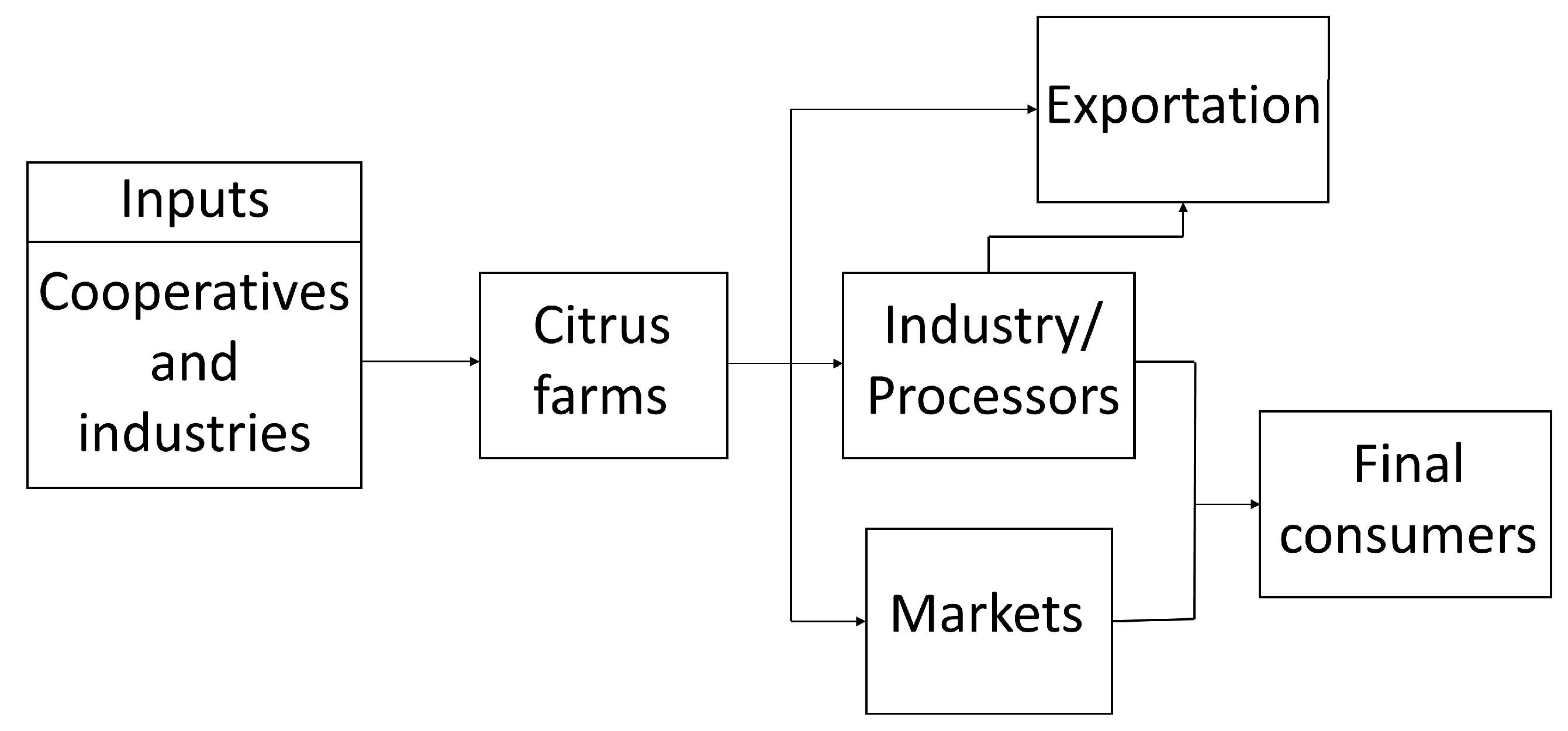

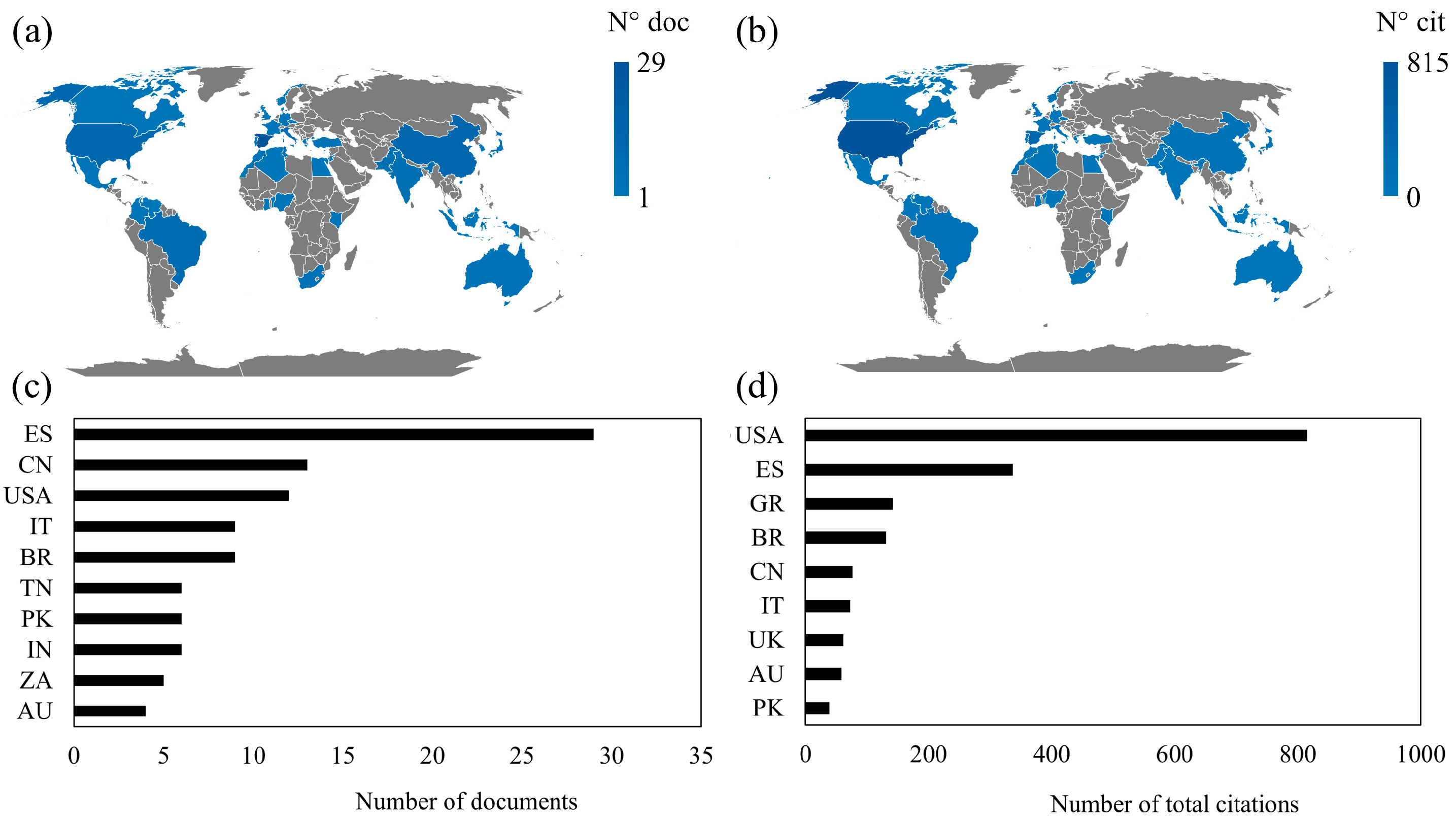
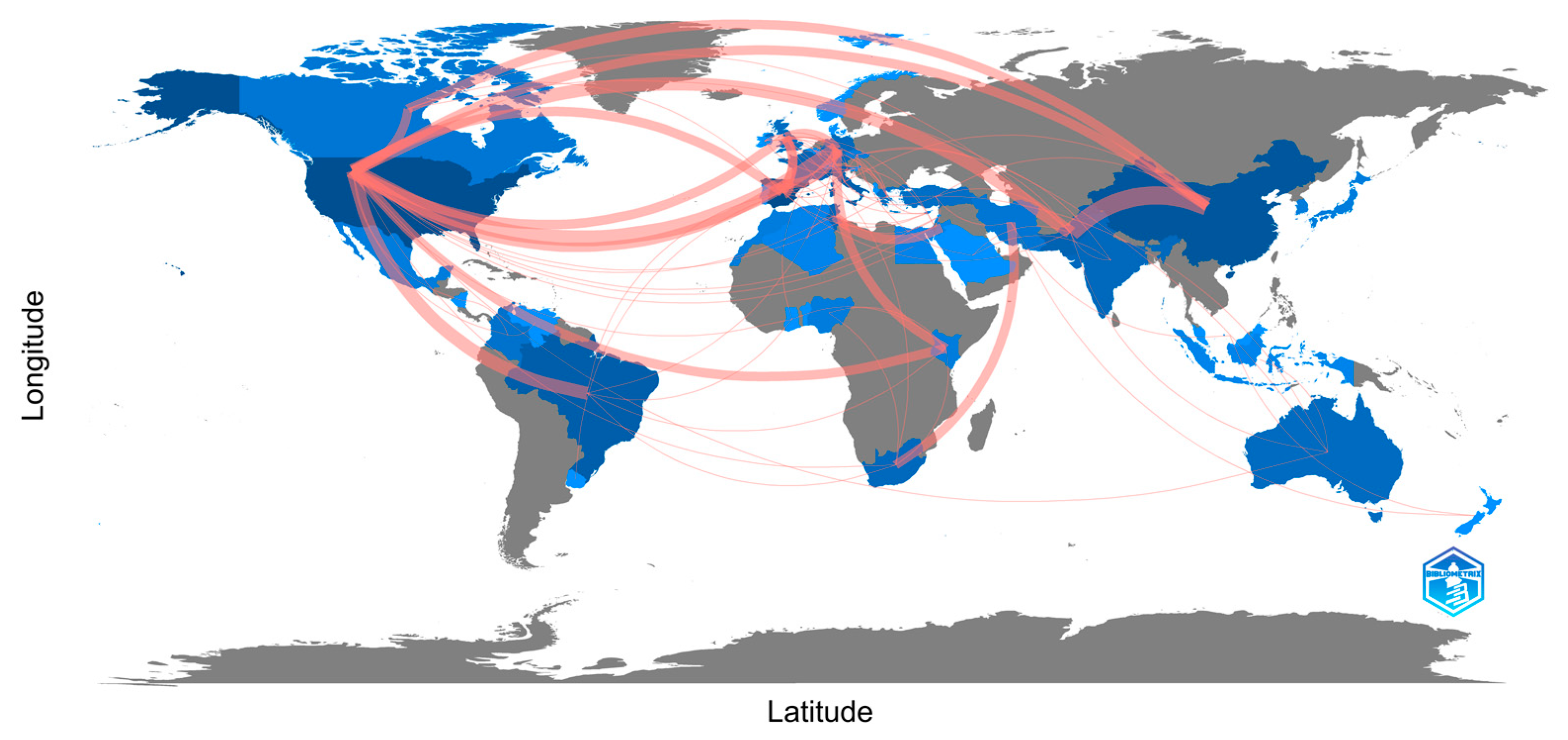
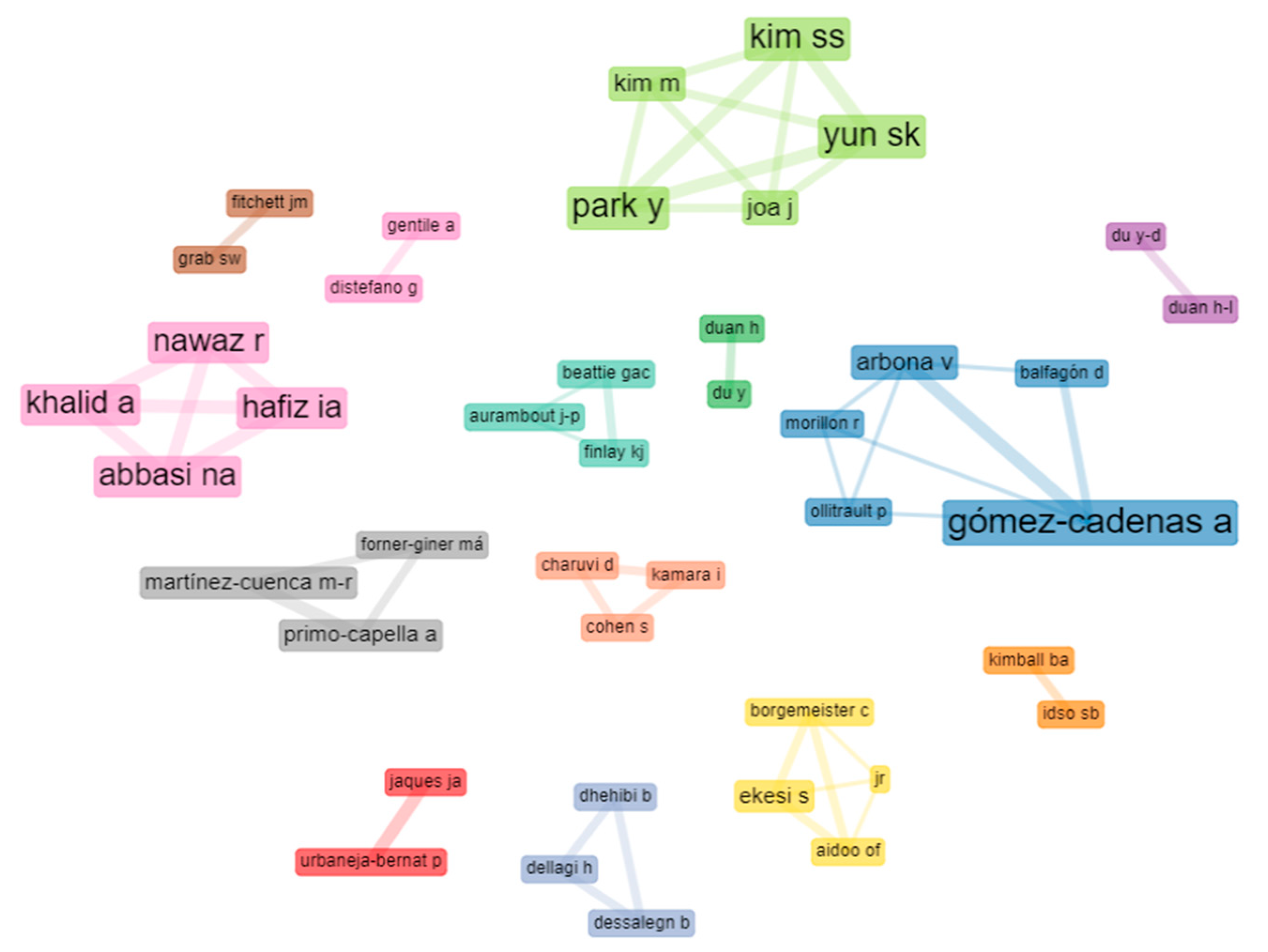
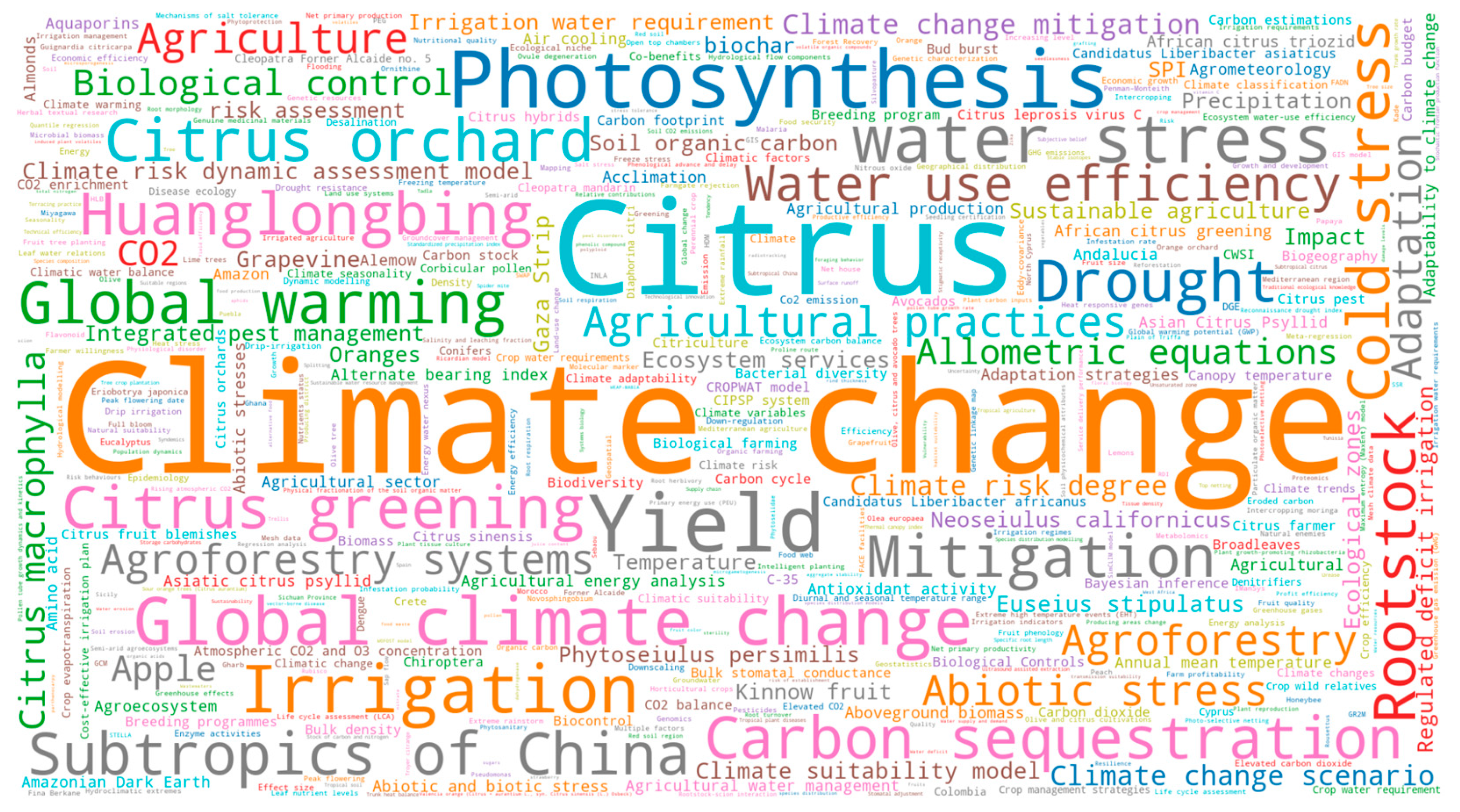
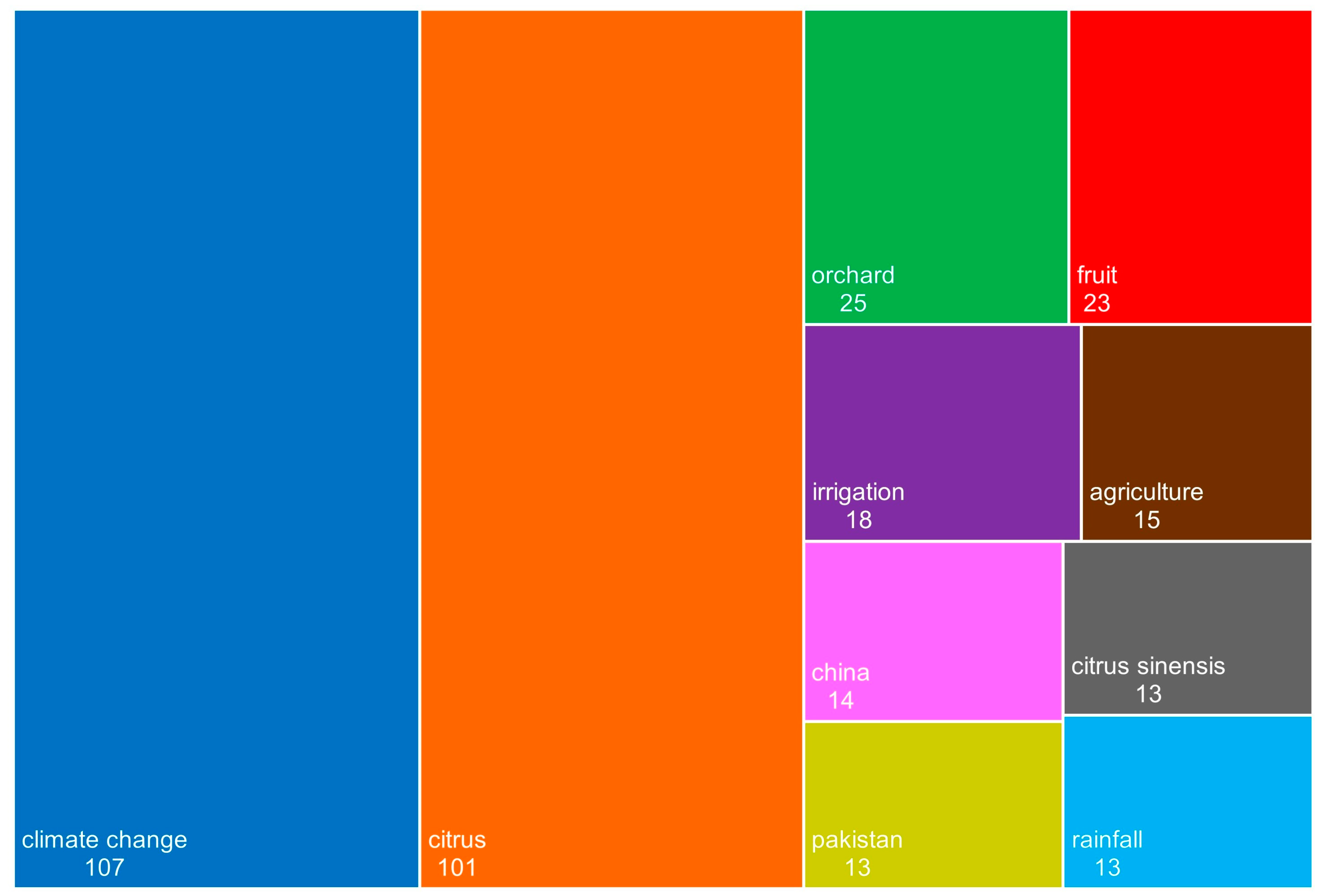
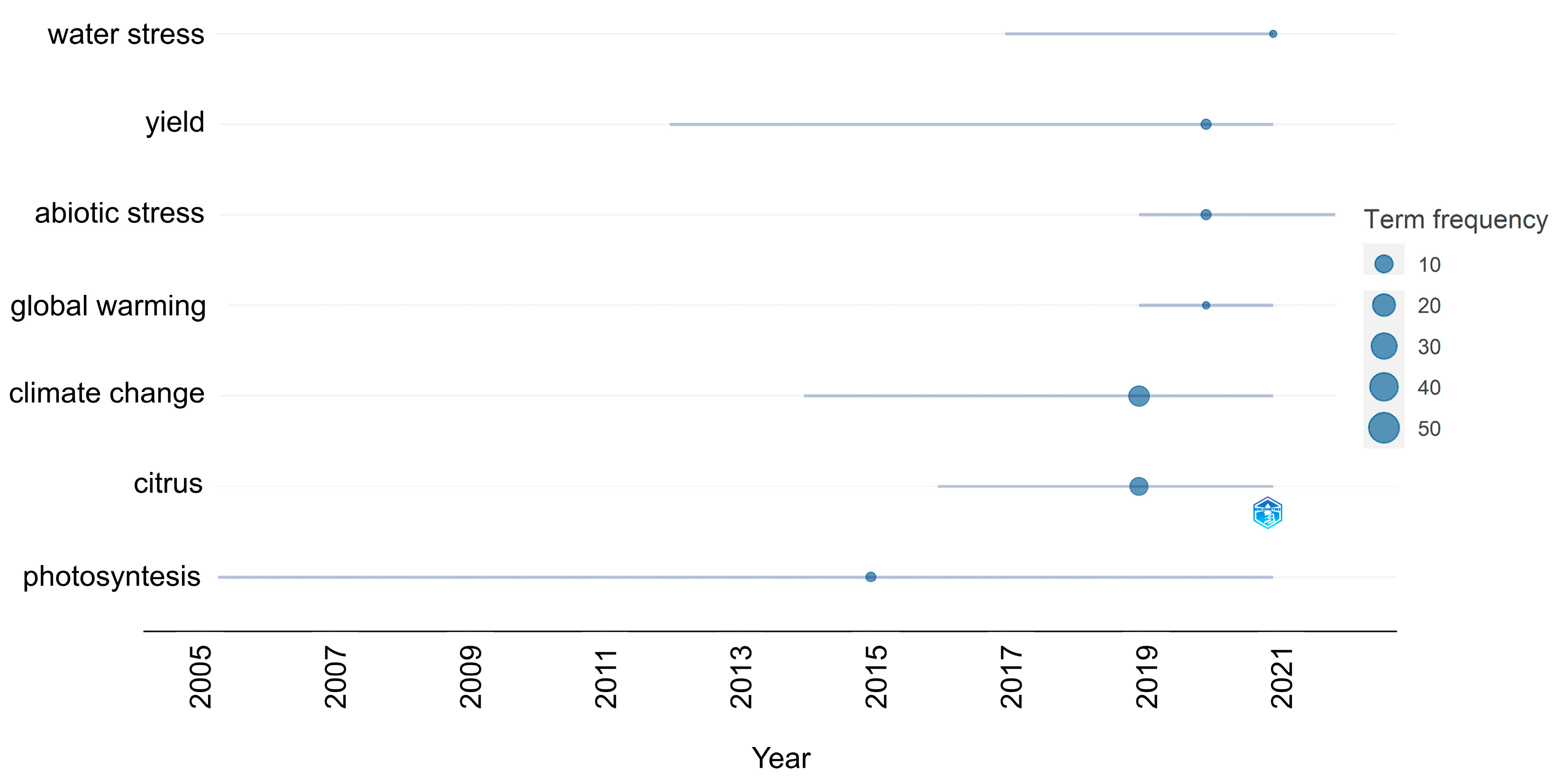
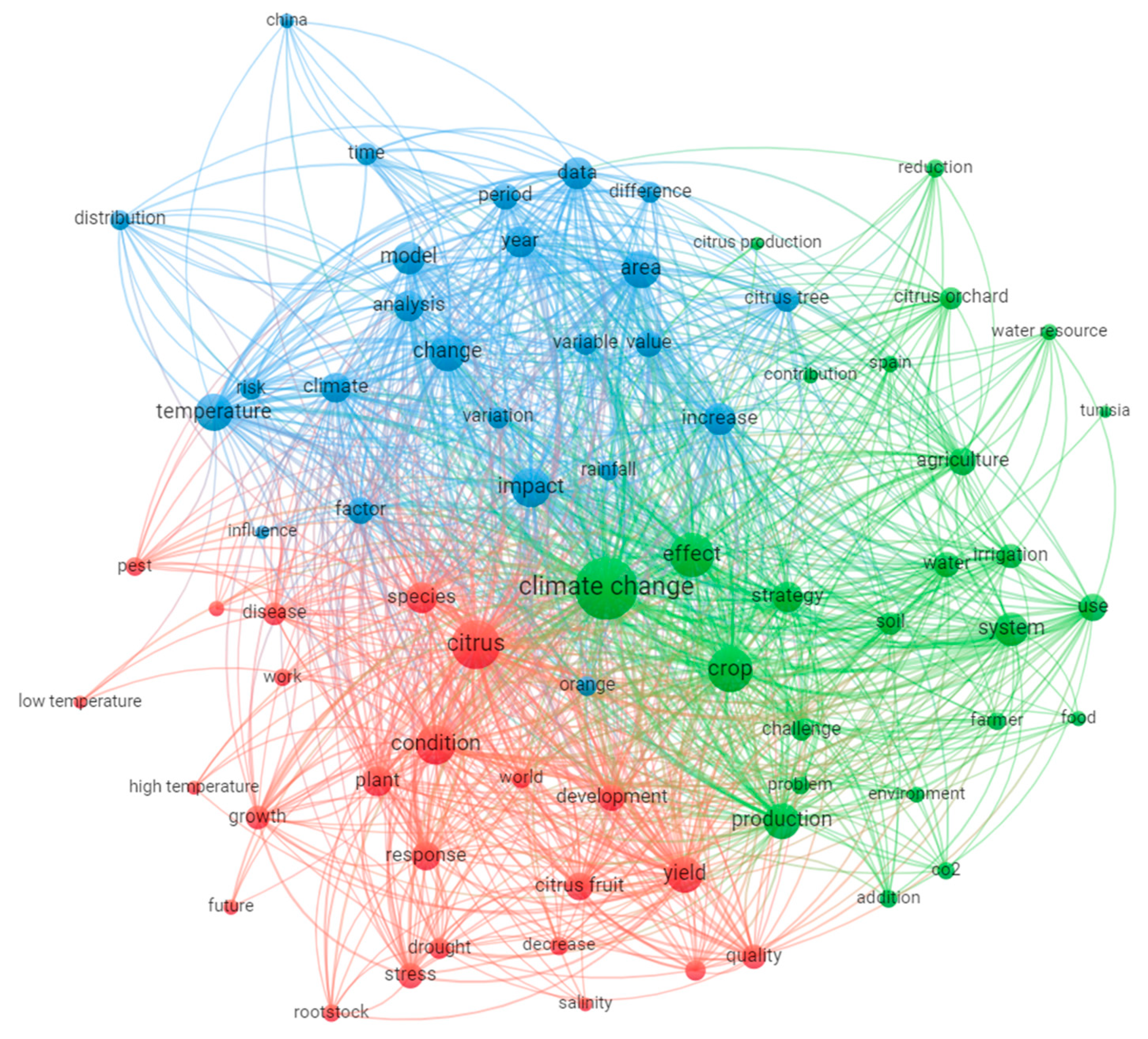
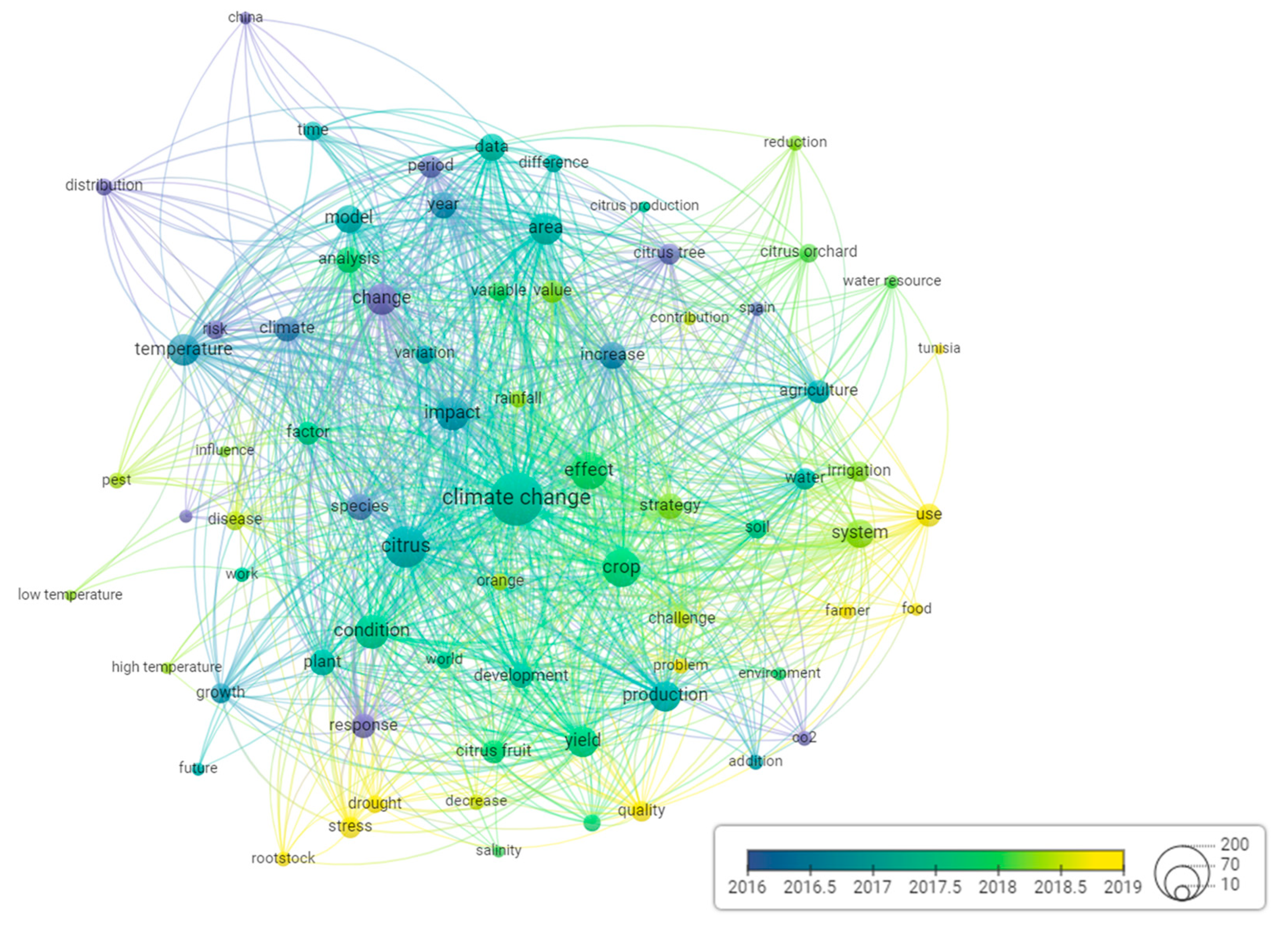
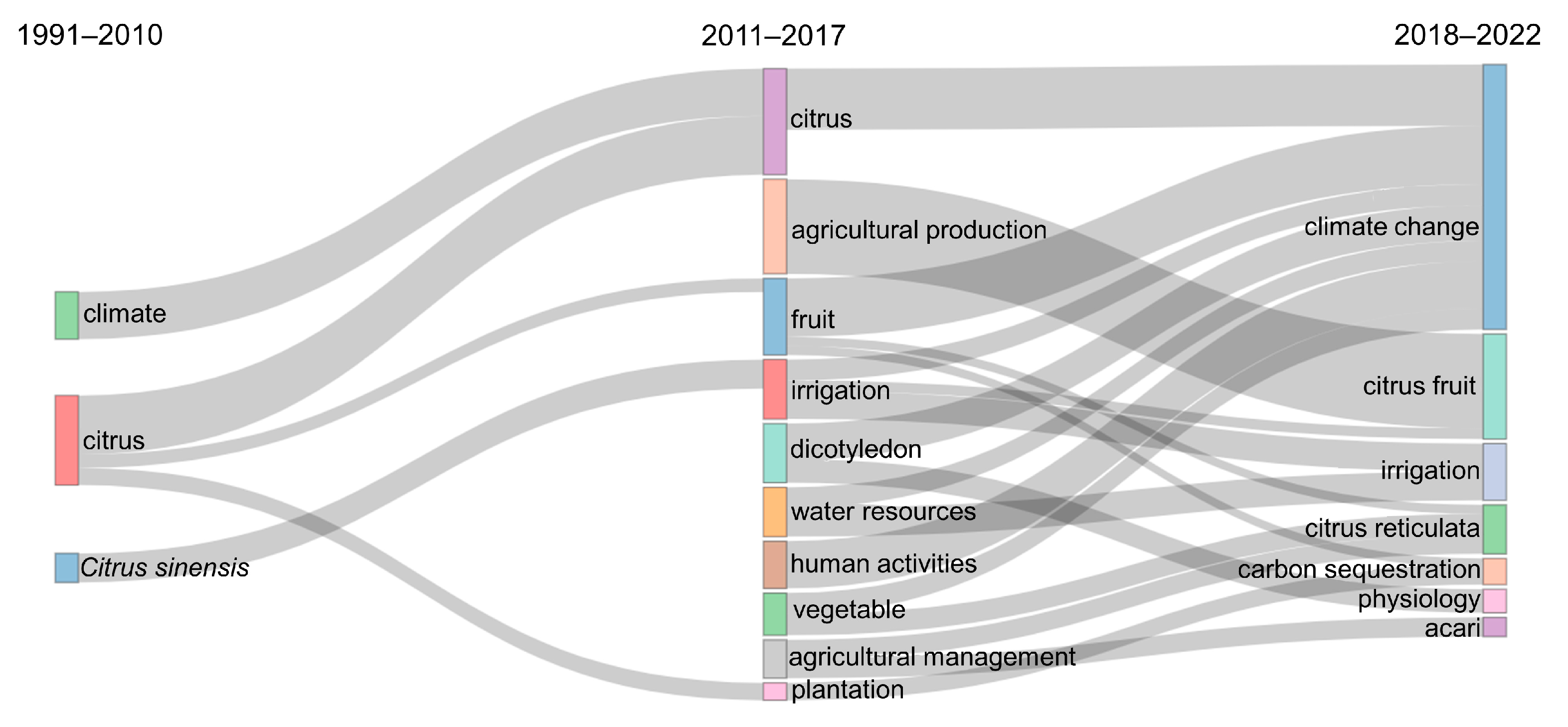


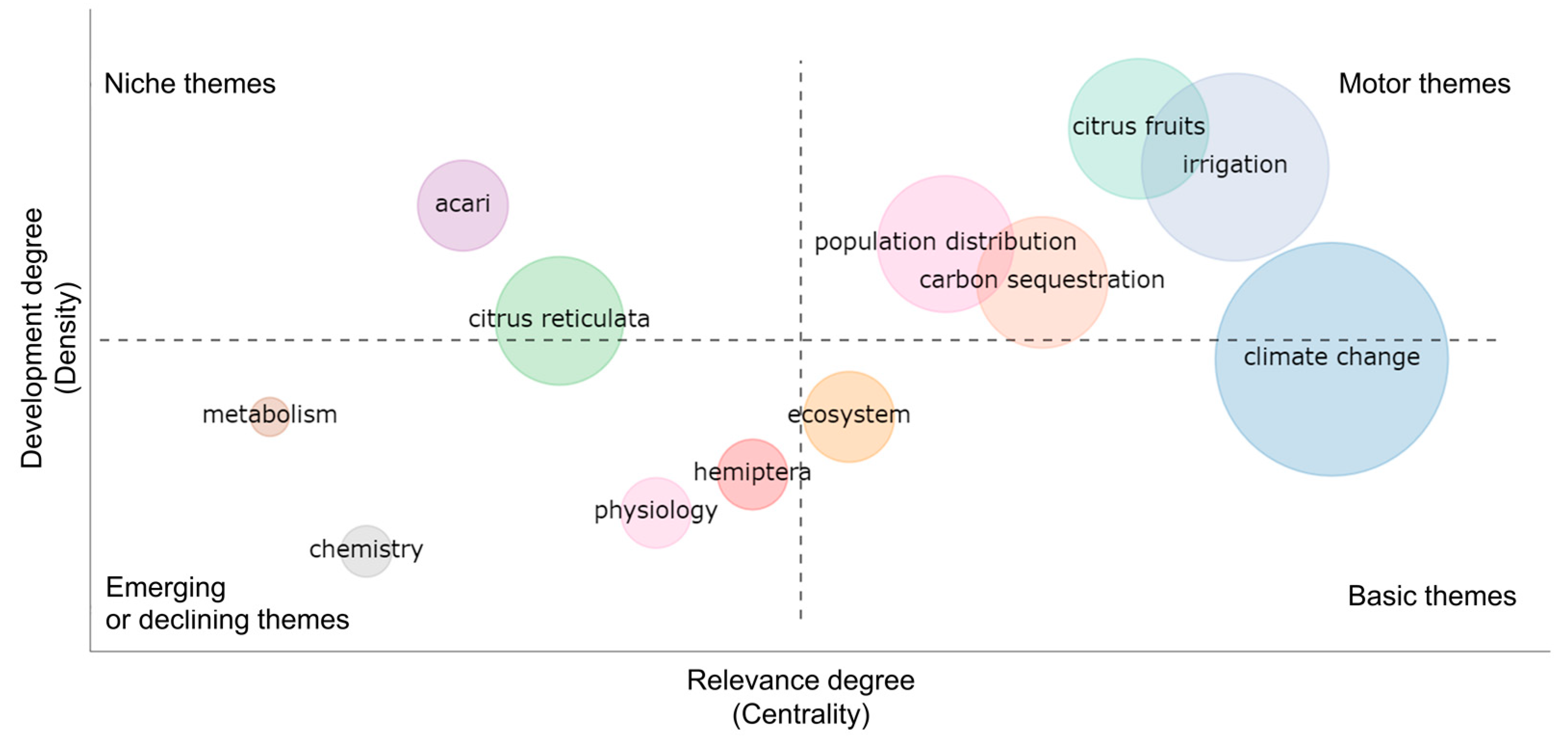
Disclaimer/Publisher’s Note: The statements, opinions and data contained in all publications are solely those of the individual author(s) and contributor(s) and not of MDPI and/or the editor(s). MDPI and/or the editor(s) disclaim responsibility for any injury to people or property resulting from any ideas, methods, instructions or products referred to in the content. |
© 2023 by the authors. Licensee MDPI, Basel, Switzerland. This article is an open access article distributed under the terms and conditions of the Creative Commons Attribution (CC BY) license (https://creativecommons.org/licenses/by/4.0/).
Share and Cite
Rasera, J.B.; da Silva, R.F.; Mourão Filho, F.d.A.A.; Delbem, A.C.B.; Saraiva, A.M.; Sentelhas, P.C.; Marques, P.A.A. Climate Change and Citriculture: A Bibliometric Analysis. Agronomy 2023, 13, 723. https://doi.org/10.3390/agronomy13030723
Rasera JB, da Silva RF, Mourão Filho FdAA, Delbem ACB, Saraiva AM, Sentelhas PC, Marques PAA. Climate Change and Citriculture: A Bibliometric Analysis. Agronomy. 2023; 13(3):723. https://doi.org/10.3390/agronomy13030723
Chicago/Turabian StyleRasera, Júlia Boscariol, Roberto Fray da Silva, Francisco de Assis Alves Mourão Filho, Alexandre Cláudio Botazzo Delbem, Antonio Mauro Saraiva, Paulo Cesar Sentelhas, and Patricia Angélica Alves Marques. 2023. "Climate Change and Citriculture: A Bibliometric Analysis" Agronomy 13, no. 3: 723. https://doi.org/10.3390/agronomy13030723
APA StyleRasera, J. B., da Silva, R. F., Mourão Filho, F. d. A. A., Delbem, A. C. B., Saraiva, A. M., Sentelhas, P. C., & Marques, P. A. A. (2023). Climate Change and Citriculture: A Bibliometric Analysis. Agronomy, 13(3), 723. https://doi.org/10.3390/agronomy13030723







